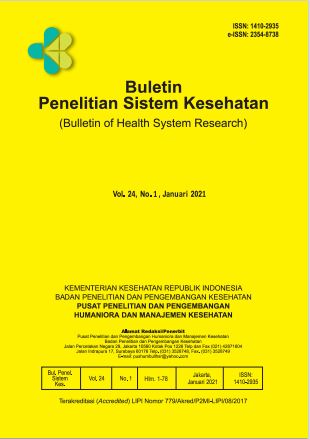Association of Smoking Related to Knowledge, Attitude, and Practice (KAP) with Tobacco Use in Community Health Center Working Area of Sungai Durian, Sintang Regency, West Kalimantan Province
Abstract
Tobacco use is one of the predicting factors of non-communicable diseases. In 2003, cigarette consumption was the main factor contributing to 4.9 million deaths in developing countries. In 2020, Bureau of Statistics Indonesia reported 31.5% of Indonesian population were tobacco users. Particularly, in West Kalimantan province, more than one-fourth of men are smokers. Specifically, in the working area of Sungai Durian Primary Healthcare Center, third-fourth of men are smokers. This study was conducted to examine the relationship between Knowledge, Attitude, and Practice (KAP) with tobacco use. This cross-sectional study employed 218 respondents of 4,321 male population. The predicting factors in this study were knowledge, attitude, and practice. The statistical test was done using univariate, bivariate (Chi-Square), and multivariate (binary logistic regression) analyses. The bivariate analysis test showed that knowledge and practice were significantly associated with tobacco use. Regarding the multivariate analysis results, practice was the strongest factor affecting tobacco use (AOR= 4.25, CI 95% (1.93 – 9.36)), and the second strongest factor was knowledge (AOR=
2.46, CI 95% (1.00 – 6.04)). Tobacco use in the working area of Sungai Durian Primary Healthcare Center was mostly affected by practice. Primary healthcare centers as the nearest healthcare facility in the community need to improve health education and decrease tobacco consumption. A tobacco control can be implemented by banning smoking indoors to reduce smoking behavior.
Abstrak
Penggunaan tembakau merupakan salah satu faktor risiko penyakit tidak menular. Pada tahun 2003, konsumsi rokok merupakan penyebab utama kematian 4,9 juta penduduk di negara berkembang. 31,5% penduduk Indonesia adalah pengguna tembakau berdasarkan data tahun 2000. Secara khusus di Provinsi Kalimantan Barat, lebih dari satu per empat laki-lakinya adalah perokok, dan secara lebih khusus lagi, tiga per empat laki-laki usia 20-30 tahun di wilayah kerja Puskesmas Sungai Durian adalah perokok. Studi ini dilakukan untuk menguji hubungan pengetahuan, sikap, dan perilaku terhadap penggunaan tembakau. studi cross-sectional ini melibatkan 180 perokok di antara 4,321 total populasi laki-laki. Faktor prediksi pada studi ini yaitu: pengetahuan, sikap, dan praktik. Uji statistik telah dilakukan yaitu uji tunggal, ganda (Chi-Square), dan multivariabel (binary logistic regression). Uji ganda menemukan bahwa pengetahuan dan perilaku secara signifikan berhubungan dengan penggunaan tembakau. Lebih jauh, berdasarkan hasil multivariabel, perilaku merupakan pengaruh terbesar (AOR= 4,25, CI 95% (1,93 – 9,36)) dan diikuti dengan pengetahuan (AOR= 2,46, CI 95% (1,00 – 6,04)). Penggunaan tembakau di wilayah kerja Puskesmas Sungai Durian sebagian besar dipengaruhi oleh perilaku. Puskesmas sebagai pelayanan kesehatan terdekat butuh menyelenggarakan pendidikan kesehatan untuk menurunkan konsumsi tembakau. Pengendalian tembakau yang diimplementasikan dengan larangan merokok di dalam ruangan sangat penting untuk mengurangi kebiasaan merokok.
References
Adznam, S. N. H., Sedek, R., & Kasim, Z. M. (2018). Assessment of knowledge level on anemia among pregnant women in Putrajaya (p. 020104). https://doi.org/10.1063/1.5028019
Arshad, A., Matharoo, J., Arshad, E., Sadhra, S. S., Norton-wangford, R., & Jawad, M. (2019). Knowledge, attitudes, and perceptions towards waterpipe tobacco smoking amongst college or university students : a systematic review. BMC Public Health, 19(439), 1–11. https://doi.org/10.1186/s12889-019-6680-x
Bafunno, D., Catino, A., Lamorgese, V., Longo, V., Montrone, M., Pesola, F., … Galetta, D. (2020). Smoking Prevalence, Knowledge, and Perceptions on Tobacco Control Among Healthcare Professionals : A Survey in an Italian Cancer Center. Journal of Community Health, (0123456789). https://doi.org/10.1007/s10900-020-00907-8
Bak, J., & Piko, B. (2007). The smoke-free world for children’s welfare: Perceptions of smoking in preadolescence. Children and Youth Services Review, 29(3), 283–293. https://doi.org/10.1016/j.childyouth.2006.07.007
Borrelli, B., Hayes, R. B., Dunsiger, S., & Fava, J. L. (2010). Risk perception and smoking behavior in medically ill smokers: A prospective study. Addiction, 105(6), 1100–1108. https://doi.org/10.1111/j.1360-0443.2010.02900.x
Central Bureau of Statistics Indonesia. (2011). Kematian Bayi dan Angka Harapan Hidup Penduduk Indonesia Hasil Sensus Penduduk 2010 (Infant Mortality and Life Epxectancy Indonesian Population Result of Population Census 210).
César, A., Leonel, S., Rogério, P., Bonan, F., Freire, J., & Castro, L. De. (2019). Tobacco Use, Attitudes, Knowledge, and Perception About Smoking Cessation Counseling Among Brazilian Dental Students : a Cross-Sectional Study. Journal of Cancer Education.
Davidson, G.C & Neale, J. M. (1990). Abnormal Psychology. New York: John Willey & Sons.
Dilliott, D., Fazel, S., Ehsan, N., & Sibbald, S. L. (2020). The attitudes and behaviors of students, staff, and faculty towards smoke-free and tobacco-free campus policies in North American universities : A narrative review. Tobacco Prevention & Cessation, 1–7.
Eysenck, H. J. (2017). Smoking, Health & Personality. Routledge. New York: Routledge.
Gucuk, S., & Yildirmaz, I. L. (2019). Knowledge on Tobacco Control Campaigns and Recommendations for Reduction of Tobacco Use : A Cross-Sectional Study Recommendations for Reduction of Tobacco Use. Turkish Journal of Family Medicine and Primary Care, 13(1), 34–41. https://doi.org/10.21763/tjfmpc.528009
Haq, I. U., Liu, Y., Liu, M., Xu, H., Wang, H., Liu, C., … Feng, Q. (2019). Association of smoking-related knowledge, attitude, and practices (kap) with nutritional status and diet quality: A cross-sectional study in China. BioMed Research International, 2019. https://doi.org/10.1155/2019/5897478
Hasanah, H. (2014). Baby Smoker: Perilaku Konsumsi Rokok Pada Anak dan Strategi Dakwahnya. Sawwa: Jurnal Studi Gender Dan Anak, 9(April), 253–274.
Heath, J., & Crowell, N. A. (2007). Factors Influencing Intentions to Integrate Tobacco Education Among Advanced Practice Nursing Faculty. Journal of Professional Nursing, 23(4), 189–200. https://doi.org/10.1016/j.profnurs.2007.01.016
Hiilamo, H., & Glantz, S. A. (2015). Implementation of effective cigarette health warning labels among low and middle-income countries: State capacity, path-dependency, and tobacco industry activity. Social Science and Medicine, 124(May 2013), 241–245. https://doi.org/10.1016/j.socscimed.2014.11.054
Kahar, P., Misra, R., & Patel, T. G. (2016). Sociodemographic Correlates of Tobacco Consumption in Rural Gujarat, India. BioMed Research International, 2016. https://doi.org/10.1155/2016/5856740
Kartika, V., & Rachmawati, T. (2017). Roles Agents of Changes on Control of Non Communicable Diseases in Indihiang Subdistrict , Tasikmalaya City. Buletin Penelitian Sistem Kesehatan, 20(4), 182–191. http://ejournal2.litbang.kemkes.go.id/index.php/hsr/article/view/77.
Kaufman, A. R., Dwyer, L. A., Land, S. R., Klein, W. M. P., & Park, E. R. (2018). Smoking-related health beliefs and smoking behavior in the National Lung Screening Trial. Addictive Behaviors, 84(November 2017), 27–32. https://doi.org/10.1016/j.addbeh.2018.03.015
Lestari, W., & Wulansari, S. (2018). Interactive ’ s Puppet Show as Health Promotion Media for Adolescent on Cigarettes, Drugs, and Promiscuity. Buletin Penelitian Sistem Kesehatan, 21(2), 125–132. https://doi.org/10.22435/hsr.v21i2.262.
Mayne, S. L., Auchincloss, A. H., Tabb, L. P., Stehr, M., Shikany, J. M., Schreiner, P. J., … Gordon-Larsen, P. (2018). Associations of Bar and Restaurant Smoking Bans with Smoking Behavior in the CARDIA Study: A 25-Year Study. American Journal of Epidemiology, 187(6), 1250–1258. https://doi.org/10.1093/aje/kwx372
MK, K., HE, H., & J, F. (2019). Knowledge and Attitude Regarding National Tobacco Control Law and Practice of Tobacco Smoking among Bangladesh Police. Mymensingh Med, 28(4).
MoH Indonesia. (2008). Laporan Nasional Riskesdas 2007 [National Report on Basic Health Research 2007]. Kementerian Kesehatan Republik Indonesia, 1–384.
Mubarak, Wahit Iqbal, D. (2007). Promosi Kesehatan Sebuah Pengantar Proses Belajar Mengajar dalam Pendidikan. Yogyakarta: Graha Ilmu.
Nainggolan, O., Dharmayanti, I., & Kristanto, A. Y. (2020). Hubungan Antara Perilaku Merokok Anggota Rumah Tangga dengan Perilaku Merokok Remaja di Indonesia (Analisis Data Riskesdas Tahun 2018). Buletin Penelitian Sistem Kesehatan, 23(2), 80–88. https://doi.org/10.22435/hsr.v23i2.3104.
Noe, M., Aung, H., Yamamoto, E., Ko, M. H., Khaing, M., Reyer, J. A., & Hamajima, N. (2019). Knowledge, attitude, and usage pattern of tobacco among high school students in Nay Pyi Taw, Myanmar. Nagoya J Med Sci, 81, 65–79. https://doi.org/10.18999/nagjms.81.1.65
Notoatmodjo, S. (2005). Pendidikan dan Perilaku Kesehatan. Jakarta: PT Rineka Cipta.
Rahim, F. K., Suksaroj, T., & Jayasvasti, I. (2016). The social determinant of the health of adult smoking behavior: Differences between urban and rural areas in Indonesia. Kesmas, 11(2), 51–55. https://doi.org/10.21109/kesmas.v11i2.1237
Rahmadi, A., Lestari, Y., & Yenita. (2013). Hubungan Pengetahuan dan Sikap Terhadap Rokok Dengan Kebiasaan Merokok Siswa SMP di Kota Padang. Jurnal Kesehatan Andalas, 2(1), 25–28.
Rashiden, I., Amani, N., Tajuddin, A., Yee, A., Tan, S., Zhen, E., & Siddiq, A. (2020). The efficacy of smoking ban policy at the workplace on secondhand smoking : systematic review and meta-analysis. Environmental Science and Pollution Research, 27, 29856–29866.
Saito, A., Nishina, M., Murai, K., Mizuno, A., Ueshima, F., Makiishi, T., & Ichinohe, T. (2010). Health professional’s perceptions of and potential barriers to smoking cessation care: A survey study at a dental school hospital in Japan. BMC Research Notes, 3(1), 329. https://doi.org/10.1186/1756-0500-3-329
Sirait, A. M., Pradono, Y., & Toruan, I. L. (2002). Perilaku Merokok di Indonesia. Buletin Penelitian Kesehatan, 30(3).
Sukmana, T. (2011). Mengenal Rokok dan Bahayanya. Jakarta: E Champion.
Sutherland, R. A. (2020). Tobacco Use, Knowledge Of Tobacco Risks, And Perception Of Smoking Behaviors Among Urban And Rural Youth In South Sulawesi, Indonesia. Yale University.
Svancarová, I., Kulhánek, A., & Fidesová, H. (2019). Changes in tobacco use patterns and motivation to quit related to the new smoke-free legislation in the Czech Republic, 1–7. https://doi.org/10.1093/pubmed/fdz156
Tezera, N., & Endalamaw, A. (2019). Current Cigarette Smoking and Its Predictors among school-going Adolescents in East Africa: A Systematic Review and Meta-Analysis. International Journal of Pediatrics, 2019, 1–9. https://doi.org/10.1155/2019/4769820
Veeranki, S. P., Mamudu, H. M., John, R. M., & Ouma, A. E. O. (2015). Prevalence and correlates of tobacco use among school-going adolescents in Madagascar. Journal of Epidemiology and Global Health, 5(3), 239–247. https://doi.org/10.1016/j.jegh.2014.12.005
Weinberger, A. H., Kashan, R. S., Shpigel, D. M., Esan, H., Taha, F., Lee, C. J., … Goodwin, R. D. (2017). Depression and cigarette smoking behavior: A critical review of population-based studies. American Journal of Drug and Alcohol Abuse, 43(4), 416–431. https://doi.org/10.3109/00952990.2016.1171327


















